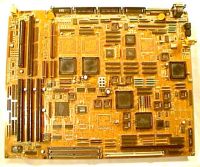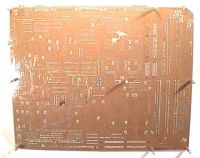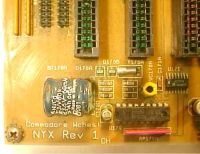
AMIGA NYX

Developer: Commodore
Year of Development: 1992 |
The Nyx was a stop-gap solution that would have provided a basic
platform for OS development. Designed by Dave Haynie in 1992, the board
is described as a 'kludge' to verify the AAA
chipset and was based upon the A3000 architecture.
The Nyx motherboard did not require a CPU, but contained a standard A3000
CPU module and (an estimated) '16 expensive, fast PAL devices'. In retrospect,
Dave Haynie indicates that the same result could be produced using ' a
modest CPLD or FPGA'. Only three are known to have existed, their current
location is unknown.
In October 2001 Dave Haynie sold his Nyx prototype on the online auction
site, eBay. In his sale description he provided a considerable amount of
information on the origin of the Nyx motherboard. This is reproduced in
its entirety below:
Unlike most Amiga motherboard prototypes you're likely to come by, Nyx
was never intended as a production machine. Had Commodore survived, the
first AAA systems would have been based around the Acutiator architecture.
Nyx used the Amiga 3000 architecture, and lots and lots of high-speed PAL
chips to work changes in the A3000 ideas.
From the left, you'll see a combination Zorro III/video slot. The next
slot over is a Zorro III/graphics slot. The graphics bus would allow direct
digital access to the graphics bus, basically the data stream that feeds
the Monica chip (Denise replacement). A graphics input device could easily
live here. Next over is a plain Zorro III slot. Beyond that are two chip
RAM modules (one connector is missing). The Nyx system could be supplied
with either Fast-Page Mode memory or Video Memory, dual ported (FPM modules
contained additional buffers to simulate dual-ported mode) on modules which
were 32-bit, on the CPU port side, and either 32-bit or 64-bit, on the
graphics port side.
You don't see actual chips on this board. There were not many AAA chips
made, and some, such as Andrea, had to be FIBed to work at all (basically,
that's an expensive way to "rework" a chip). The two large chip holders
next to the chip RAM slots are for Linda and Monica, the line-buffer and
graphics chips. The spaces above them are for additional Linda and Monica
chips, a 64-bit graphics system would have two of each. Next large socket
over is the Andrea chip, which is the Agnus/Alice analog. Across a row
of debug-headers (this board is full of headers that allowed easy connect
to my logic analyzer) you'll find the last of the AAA chip sockets, that
of the Mary chip. Mary did the Paula functions: floppy, audio, etc.
The Nyx wasn't only about AAA, either, but in many ways, what we wanted
to see in a next-generation Amiga in general. On the bottom half of the
motherboard, you can see the SIMM modules for Fast Memory. Next to this,
there was a SIMM module for ROM, which could handle either the usual Amiga
masked ROM, or a Flash device. Above the ROM SIMM is an A3000-style CPU
module header -- the Nyx motherboard didn't have a built-in CPU. That's
also a Gary chip there, and to the right of Gary, a network of fast PALs
and clock modules.
AAA was ahead of its time, and in one way in particular -- it really
should have had on-chip PLL (phase-locked loop) clock generators. Since
it didn't, you had to supply up to four pixel clocks to the system at any
given time, which could switch one to the other without slivering. The
logic here does this. The reason was simple: well behaved screens. The
easy reason you can't get Amiga-style screens on a PC is the lack of the
copper (though many chips these days have some kind of advanced display
coprocessor). The critical reason, though, is that every display mode uses
a different pixel clock, and it takes a second or two for a PLL to settle
at a new frequency. AAA solved this by specifying up to four clocks (in
this implementation; 8 were possibly in the logical register map) that
could be selected on a line-by-line basis. By selecting different clocks,
and with line/pixel doublers in the line buffer, the system could not only
support screens, it could cleanly promote different graphics modes, whcn
mixed, so you could actually see them on the same screen.

This base shot shows the standoffs, a bit of rework, and a broken corner
on this board. This was the first functional AAA board, and also the first
to die. The death was in part purely accidental, and in part a bit of negligence.
First to blame is me. Back in those days, you needed +12V for Flash memory,
so I had this going to the Flash SIMM modules. Sadly, rather than protect
the +12V signal with grounds on either side, or some-such, I pretty much
ignored the signal neighbors. This is not the best decision, since a +12V
shorted to a normal TTL-level input can destory that input.
Second problem was the ROM SIMM itself. The PCB guys messed up just
slightly here, so the SIMM didn't fit tightly in the connector, but could
slide left or right a bit. Which allowed adjacent pins to occasionally
short out. Fortunately, I noticed this early on, and did not allow a short
to occur. Unfortunately, some of the chip designers didn't know about this,
and one day tried to start up the board when I wasn't account. The result
was a +12V short to data-line D5, killing much of the system. Well, hey,
these things happen, and we had two other boards. Those boards went with
some of the top chip guys on the AAA project. Far as I know, at least one
of those was still functional, or at least as functional as these things
got.

We had planned a low-cost (for the day) built-in network. based on Arcnet
chips. The keyboard port, while compatible with the A3000/A4000, could
also run in a "desktop bus" mode, similar in concept to the Apple Desktop
Bus or the DEC Access.bus, similar in implementation to Commodore's old
serial peripheral bus for the VIC-20/C64/C128. Lots of fun stuff, and sad
"coulda/shoulda been" stuff in here.
Thanks to Dave Haynie for allowing the use of these images
and text.
Related Subjects
Amiga AAA
BACK
Last Update: 1/11/2001
|












